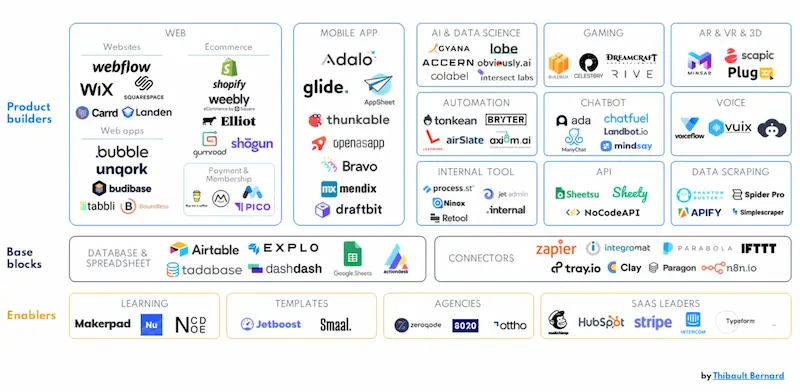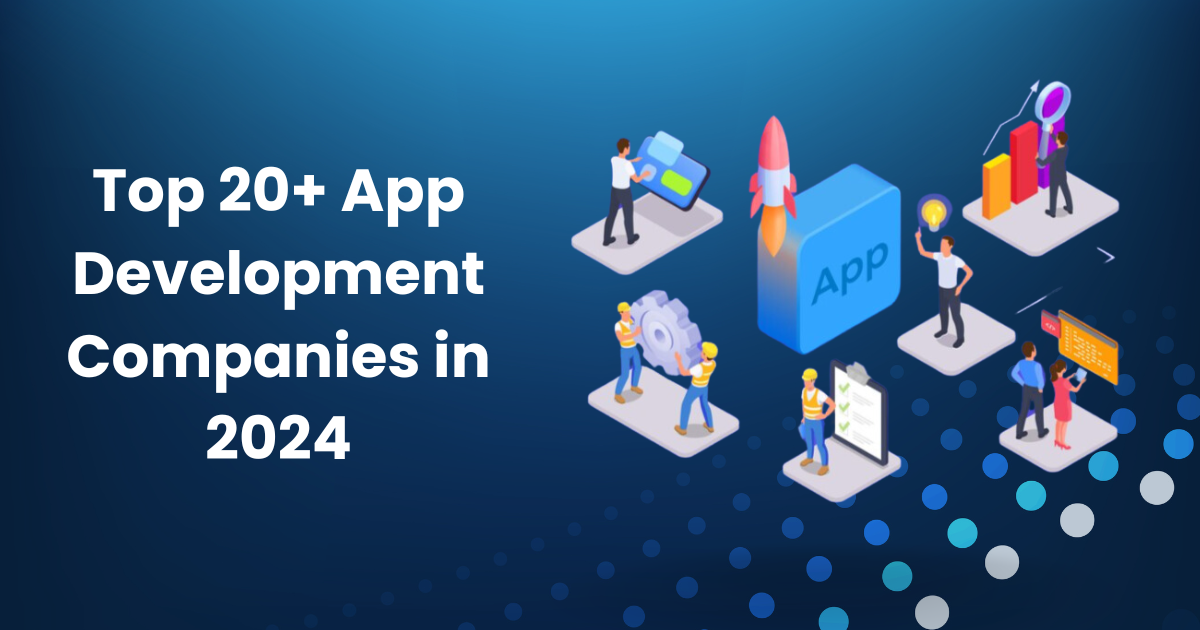No-code tools have revolutionized the way businesses approach software development. With no-code tools, anyone can build complex IT systems without having to write a single line of code. This approach not only saves time but also significantly reduces the cost of software development. No-code tools are becoming more popular among businesses due to their ease of use, cost-effectiveness, and efficiency.
Examples of No-Code Tools
Here are three examples of no-code tools that businesses can use to build complex IT systems:
- NocoBase
- Bubble
- Adalo
No-code tools are becoming more popular across different industries due to their ease of use and efficiency. These three tools are just a few examples of the many no-code tools available to businesses looking to streamline their software development processes.
No-Code vs. Low-Code Tools
In the world of IT development, the terms no-code and low-code are often used interchangeably, but they are not the same thing. While both approaches aim to simplify the development process, there are significant differences between them.
No-code tools allow users to create software without writing a single line of code. These tools use drag-and-drop interfaces and pre-built modules to enable users to design and deploy applications quickly. On the other hand, low-code tools require some coding knowledge to build more complex applications, but the development process is still streamlined with pre-built components.
One of the advantages of no-code tools is that they require less technical knowledge and can be used by non-technical people. This makes them an excellent option for startups and small businesses that may not have the resources to hire a dedicated developer. In addition, no-code tools often have a shorter development time, which can save businesses money and time in the long run.
On the other hand, low-code tools can offer more flexibility and customization options, making them a better choice for larger businesses with more complex needs. While they may require some coding knowledge, they still provide a streamlined development process, which can lead to faster project completion times.
When choosing between no-code and low-code tools, it is essential to consider the specific needs of your business and the skills of your team. No-code tools are excellent for those without much technical knowledge, while low-code tools offer more customization options for those with coding experience.
No-Code Tools for Startups
Startups often have limited resources, including time and money, so it’s essential to use tools that can help them quickly build and launch products. No-code tools are an excellent option for startups as they can help them save time and money on development costs.
One example of a no-code tool for startups is Bubble.io. Bubble.io is a web-based platform that allows users to design and launch web and mobile applications without writing any code. It is a drag-and-drop platform that makes it easy for users to build applications quickly.
Another no-code tool that can benefit startups is Glide. Glide allows users to turn spreadsheets into web and mobile applications. This is an excellent option for startups that want to build simple applications quickly and without much technical knowledge.
Finally, Zapier is another no-code tool that can be useful for startups. Zapier is an automation platform that allows users to connect different applications and automate workflows. This can help startups streamline their processes and save time on manual tasks.
In conclusion, no-code tools offer a cost-effective and efficient way for startups to quickly build and launch applications. Bubble.io, Glide, and Zapier are three examples of no-code tools that can benefit startups in different industries.
You might also like
saas
User Interface for marketplace
NFT (non-fungible tokens) is a digital asset that represents ownership of unique assets like digital art, music, and real estate. NFTs have been gaining popularity in recent years, particularly in the metaverse, where they play an important role in the virtual world’s economy. NFTs are stored on a blockchain, which ensures their scarcity and uniqueness, […]

Are No-Code Tools Worth It?
As a startup founder, you may be wondering if using no-code tools is worth it. The short answer is yes! No-code tools are cost-effective, easy to use, and can help you build IT solutions quickly.
Cost-effectiveness is one of the most significant advantages of no-code tools. Hiring a professional developer to build your app can be expensive, but with no-code tools, you can build your app yourself without any coding knowledge. No-code tools typically offer a subscription-based model, so you can start building your app for as little as $10 per month.
No-code tools are also easy to use, making them accessible to anyone, regardless of technical ability. Most no-code tools use drag-and-drop interfaces and offer pre-built templates and components, making app development a breeze.
OpenAI Business Model and GPT-3 Applications
OpenAI is a company that specializes in artificial intelligence research and development. They have developed a powerful AI model called GPT-3, which can generate human-like language and complete tasks such as translation, summarization, and text completion.
GPT-3 has many applications in various industries, from healthcare to finance. Many companies are already using GPT-3 to develop new products and services. For example, Copy.ai is a web application that uses GPT-3 to generate marketing copy. Web ChatGPT is another web-based application that uses GPT-3 to power its chatbot platform. And, iOS GPT App is an iOS app that uses GPT-3 to generate writing prompts for writers.
OpenAI has adopted a unique business model where they offer GPT-3 as an AI-as-a-Service (AIaaS) product. This means that businesses can use GPT-3 through OpenAI’s API as a service. The pricing model is based on usage, making it cost-effective for startups and small businesses.
In conclusion, using no-code tools can be a cost-effective and easy way to build IT solutions for your startup. OpenAI’s GPT-3 model has many applications in various industries and can be accessed through their AIaaS product. Consider implementing no-code tools and exploring GPT-3’s capabilities for your startup’s success.
AI Consulting and AI Consultants
AI consulting is a service that provides businesses with expert guidance on how to use AI technology to improve their operations. AI consultants can help identify areas where AI can be implemented, develop AI solutions, and provide ongoing support.
Working with an AI consultant can provide many benefits, including faster implementation times, reduced development costs, and increased ROI. One example of an AI consultancy is Cognizant, which offers a range of AI services for businesses of all sizes.
No-Code Development with GPT
GPT-3 can be used for no-code development by providing natural language input to generate code. This can be especially helpful for non-technical team members who may not have experience with traditional programming languages.
However, there are limitations to using GPT-3 for no-code development, including the need for precise input and the potential for errors in generated code. It’s important to weigh the benefits and limitations before deciding to use GPT-3 for no-code development.
In conclusion, no-code tools and AI technology can provide significant benefits to startups looking to create IT solutions quickly and cost-effectively.
No-Code Tools: Benefits, Limitations, and Future
No-code tools have been gaining popularity among businesses looking to streamline their development processes. These tools allow users to create software applications without requiring extensive coding knowledge or technical skills. Pragmatic DLT has compiled a list of no-code tools that can help businesses build IT solutions quickly and efficiently. While there are many benefits to using no-code tools, there are also limitations and potential drawbacks that businesses should be aware of before implementing them.
Disadvantages of No-Code Tools
One of the primary limitations of no-code tools is that they may not be as customizable as traditional software development methods. While these tools offer a range of pre-built templates and components, businesses may not be able to customize every aspect of their application. Additionally, some no-code tools may have limitations in terms of scalability, which can hinder their ability to grow alongside a business.
Another potential drawback of using no-code tools is that they may not be suitable for complex applications that require a high degree of functionality. While no-code tools can be great for building simple applications, they may not be able to handle more complex workflows or processes. In some cases, businesses may need to combine no-code tools with traditional coding methods to create a fully functional application.
Finally, businesses should be aware that no-code tools may not always be the most cost-effective solution. While these tools can be faster to implement than traditional coding methods, they may require ongoing fees for maintenance and updates. Depending on the specific needs of a business, it may be more cost-effective in the long run to invest in traditional software development methods.
Conclusion
In conclusion, no-code tools can be a valuable resource for businesses looking to quickly and efficiently develop IT solutions. These tools offer a range of benefits, including faster development times, lower costs, and greater accessibility for non-technical users. However, businesses should also be aware of the limitations and potential drawbacks of using no-code tools, including customization limitations, scalability issues, and potential costs.
Looking to the future, it is clear that no-code development will continue to grow in popularity as businesses seek to streamline their development processes. As the technology behind no-code tools continues to improve, we can expect to see more advanced features and functionality being added to these tools. Additionally, businesses may start to see an increase in AI-powered no-code tools, such as web ChatGPT apps or iOS GPT apps.
At Pragmatic DLT, we believe that businesses should consider using no-code tools as part of their development toolkit. While these tools may not be suitable for every application, they can be a powerful resource for businesses looking to quickly and efficiently build IT solutions. As a mentor, we encourage businesses to explore the various no-code tools available and to consider implementing them into their development processes





